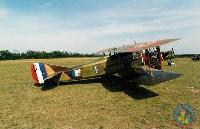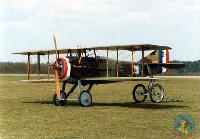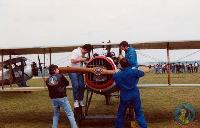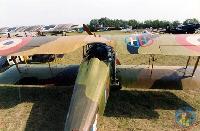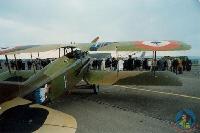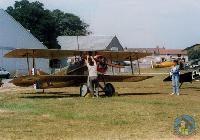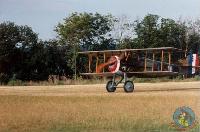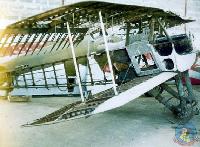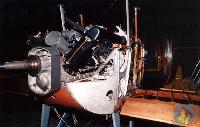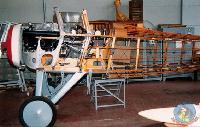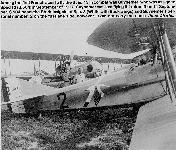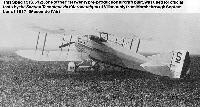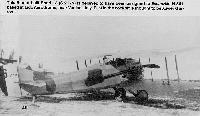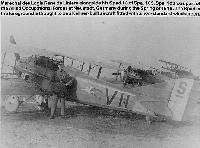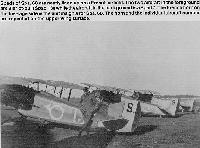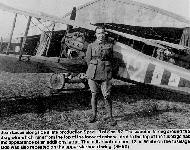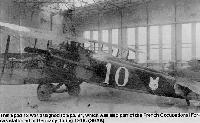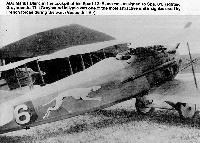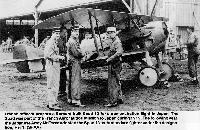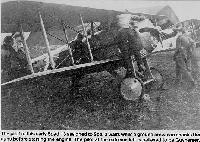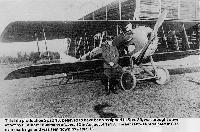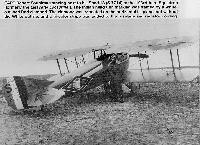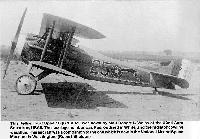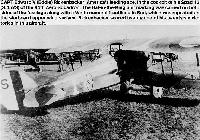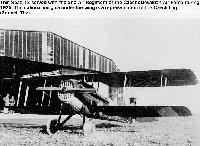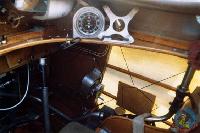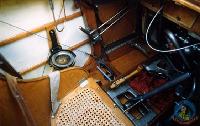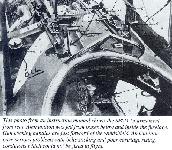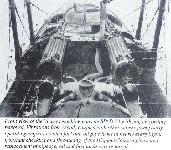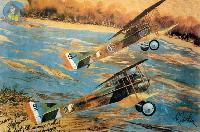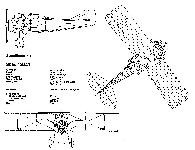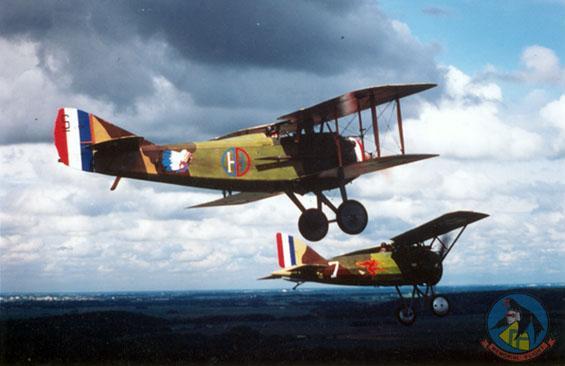
Описание
Страна: Франция
Год: 1917
Истребитель
Варианты
- SPAD - S.VII (Spa 7C-1) - 1916 - Франция
- SPAD - S.XI A.2 - 1916 - Франция
- SPAD - S.XII (Spa 12 C-1) - 1916 - Франция
- SPAD - S.XIII (Spa 13 C-1) - 1917 - Франция
- SPAD - S.XIV / S.XXIV - 1917 - Франция
- SPAD - S.XVI - 1917 - Франция
- SPAD - S.XVII / S.XXI - 1917 - Франция
- Bleriot-SPAD - S.22 - 1919 - Франция
- В.Кондратьев Самолеты первой мировой войны
- А.Шепс Самолеты Первой мировой войны. Страны Антанты
- В.Шавров История конструкций самолетов в СССР до 1938 г.
- J.Davilla, A.Soltan French Aircraft of the First World War (Flying Machines)
- W.Green, G.Swanborough The Complete Book of Fighters
- G.Swanborough, P.Bowers United States Military Aircraft Since 1909 (Putnam)
- R.Mikesh, A.Shorzoe Japanese Aircraft, 1910-1941 (Putnam)
- J.Davilla Italian Aviation in the First World War. Vol.3: Aircraft M-W (A Centennial Perspective on Great War Airplanes 75)
-
Сайт - Pilots-and-planes /WWW/
An early Spad 13 (S.1895) of Escadrille Spa.48, which was flown by ADJ Jacques Roques
-
M.Schmeelke - Ballon Hoch /Centennial Perspective/ (91)
Spad 13 flown by Lt. Leon Bourjade, Spa 152, 27 total victories, 26 balloons. Bourjade was the leading French balloon buster.
-
А.Шепс - Самолеты Первой мировой войны. Страны Антанты
SPAD S.XIII ВВС Франции
-
D.Mechin - Foreign Fronts of the French Air Force 1914-1919 /Aeronaut/
SPAD XIII n°4764 of marechal des logis Andre Levy (6 victories), escadrille N 561, Venice-Lido, October 1918.
-
M.Schmeelke - Ballon Hoch /Centennial Perspective/ (91)
Spad 13 "26" flown by First Lt. Frank Luke, 27th Aero Squadron, 18 total victories, 14 balloons. Luke was the leading American balloon buster.
-
В.Кондратьев - Самолеты первой мировой войны
Спад S XIII, эскадрилья Spa-15, пилот - су-лейтенант Г.Герен, 1918г.
-
Сайт - Pilots-and-planes /WWW/
Spad 13C.1, Sergeant Henry Foster, Spa.15, July 1918
-
В.Обухович, А.Никифоров - Самолеты Первой Мировой войны
SPAD S.13 (S.7 !)
-
Сайт - Pilots-and-planes /WWW/
A Bleriot-built Spad 13 of Spa.81 carries the running Greyhound squadron insignia. It was flown by ADJ Marius Blanc
-
А.Шепс - Самолеты Первой мировой войны. Страны Антанты
SPAD S.XIII 103-й эскадрильи Американского экспедиционного корпуса (пилот Р.Субриан; 1918г.)
-
J.Davilla, A.Soltan - French Aircraft of the First World War /Flying Machines/
SPAD 13 of 103rd Aero Squadron.
-
J.Davilla, A.Soltan - French Aircraft of the First World War /Flying Machines/
SPAD 13 of the 94th Aero Squadron.
-
А.Шепс - Самолеты Первой мировой войны. Страны Антанты
Истребитель SPAD S.XIII французского аса Шарля Нунжессера (1917г.)
-
А.Шепс - Самолеты Первой мировой войны. Страны Антанты
SPAD S.XIII 23-го эскадрона RFC (1918г.)
-
J.Davilla - Italian Aviation in the First World War. Vol.3: Aircraft M-W /Centennial Perspective/ (75)
Spad 13, Mag. Francesco Baracca, 91a Squadriglia, August 1918
-
А.Шепс - Самолеты Первой мировой войны. Страны Антанты
SPAD S.XIII итальянского аса Франческо Барраци (1917г.)
-
J.Davilla - Italian Aviation in the First World War. Vol.3: Aircraft M-W /Centennial Perspective/ (75)
Spad 13, Ten. Bertini, 91a Squadriglia, Late 1918
-
W.Pieters - The Belgian Air Service in the First World War /Aeronaut/
SPAD XIII ‘Sp26’, de Chestret de Haneffe, 10me Escadrille
-
В.Кондратьев - Самолеты первой мировой войны
Бывший французский "Спад" S XIII, захваченный турками в 1918 году на Месопотамском фронте и в дальнейшем участвовавший в греко-турецкой войне 1919-22гг.
-
W.Green, G.Swanborough - The Complete Book of Fighters
One of the 20 S.XIIIs operated by a Turkish Army aviation company between 1922 and 1930.
-
А.Шепс - Самолеты Первой мировой войны. Страны Антанты
SPAD S.XIII польских ВВС (1921г.)
-
А.Шепс - Самолеты Первой мировой войны. Страны Антанты
SPAD S.XIII 2-го полка чехословацких ВВС (1923г.)
-
Сайт - Pilots-and-planes /WWW/
This early Spad 13 is believed to have been one of the twenty pre-production aircraft built during early 1917. These aircraft had a more tapered engine cowling than the Spad 12 and also reintroduced the teardrop-shaped cylinder bank fairings, similar to those used on the Spad 7
-
Сайт - Pilots-and-planes /WWW/
Among the first French aces to fly the Spad 13 in combat was Guynemer, who was assigned Spad 13 (S.504) in September of 1917. Guynemer was lost flying this aircraft on 11 September. S.504 bears the Stork insignia of Spa.3 (White with Black wings) and Guynemer's personal number, 2 on the fuselage side, however, it did not carry the name Vieux Charles
-
Сайт - Pilots-and-planes /WWW/
This Spad 13 (S.512), one of the first twenty pre-production aircraft built, was used for official tests by the Section Technique del'Aeronautique at Villacoubly from March through September of 1917
-
J.Davilla, A.Soltan - French Aircraft of the First World War /Flying Machines/
SPAD 13 wearing the wasp insignia of SPA 89; the escadrille was assigned to GC 17.
-
R.Gentilli - Italian Aviation Units in the First World War. Vol.2 /Aeronaut/ (2)
A French Spad 13 with the insignia of a squirrel; behind it, a Pomilio of the 48a Squadriglia.
Другие самолёты на фотографии: Pomilio PC / PD / PE - Италия - 1916
-
J.Davilla, A.Soltan - French Aircraft of the First World War /Flying Machines/
SPAD 13 of SPA 48. This machine was built by Bleriot. Assigned to GC 18, SPA 48 flew bomber escort missions for Escadre de Bombardement 12 during the Battle of Picardie.
-
Сайт - Pilots-and-planes /WWW/
This Spad 13 (S.1893), flown by ADJ Jacques Roques of Spa.48, carries the later form of the unit's Fighting Cock insignia. The radiator cowling and the arc around the insignia are Blue, while Roqies' personal number, 7, is in Red
-
Сайт - Pilots-and-planes /WWW/
This early Spad 13 (S.1929) reveals the rounded wing tips that were common on early production Spad 13s. An unusual feature of this particular Spad 13 is that all the wing ribs have been taped. This aircraft also has a rear-view mirror on the upper wing center section
-
J.Davilla, A.Soltan - French Aircraft of the First World War /Flying Machines/
SPAD 13 (S.2179) of N 561 flown by Garros. This is an early Bleriot-built machine with rounded wingtips.
-
Сайт - Pilots-and-planes /WWW/
This Bleriot-built Spad 13 (S.2179) is believed to have been assigned to Escadrille N 561 based at Lido Aerodrome, near Venice, Italy. Pilot in the cockpit is thought to be Xavier Garros
-
J.Davilla, A.Soltan - French Aircraft of the First World War /Flying Machines/
These Spad 7s and 13s of an unidentified French Escadrille de Chasse parked on a forward French airfield are in the process of having the unit insignia painted on the fuselage. In the foreground is a Spad 7 (S.5190) (31905 ???), while behind is a Kellner-built Spad 13 (S.4567) (43629 ???)
Другие самолёты на фотографии: SPAD S.VII (Spa 7C-1) - Франция - 1916
-
J.Davilla, A.Soltan - French Aircraft of the First World War /Flying Machines/
SPAD 13 of Le Cicognes. Renaud.
-
Сайт - Pilots-and-planes /WWW/
Components for at least two Spad 13s, including S.7542, prepare to leave the Kellner production plant. The aircraft were shipped by truck to a reassembly RGA where they were delivered to French fighter units
-
A.Durkota, T.Darcey, V.Kulikov - The Imperial Russian Air Service /Flying Machines/
Capitaine Argeyev (or d'Argueff, to use the French spelling) beside his Bleriot-built Spad 13, No. 19. The aircraft of each pilot in Spa.124 was identified by a white number on either side of the fuselage, midway between the cockpit and the white band. The numeral was repeated in white on the upper right side of the upper wing and in black on the left lower wing. Argeyev's aircraft had the numeral 19. Every escadrille in Groupe de Combat 21 (GC 21) was identified by a diagonal band on the rear fuselage, Spa.124's band was plain white, as were the cowlings of the unit's Spads. Over the white fuselage band was a helmeted bust of Joan of Arc.
-
H.Cowin - Aviation Pioneers /Osprey/
Developed directly from the SPAD VII, the prototype SPAD XIII flew initially on 4 April 1917. Because of the high degree of commonality with its forebear, the S XIII required the minimum of flight testing and therefore could go straight into production, ensuring that initial deliveries were flowing to operational units by the end of May 1917. With its more powerful 235hp Hispano-Suiza 8 Be, the S XIII could carry two synchronised .303 inch Vickers gun and still reach the much higher top level speed of 138mph at 6.560 feet. Standardised as the prime fighter type with both the French and American Expeditionary Forces, no less than 8.472 S XIIIs were to be built by the time of the Armistice. The machine seen here is carrying Le Prieur rocket projectiles attached to its inboard interplane struts for anti-balloon or anti-airship missions.
-
Сайт - Pilots-and-planes /WWW/
This Spad at Thionville during 1923, the last year the Spad served with French military aviation. By this time most of the Spads that remained in service were being used as advanced training aircraft
-
J.Davilla, A.Soltan - French Aircraft of the First World War /Flying Machines/
SPAD 13 of SPA 37 in April 1919. By 1920 SPA 37 had become part of 101e Escadrille assigned to 1er GC.
The Spad 13 was the best French fighter in widespread use and a contender for the best operational WWI fighter. It was strong and faster than the Fokker D.VII, but not as maneuverable. Its powerful Hispano-Suiza V8 gave it excellent performance but was a maintenance headache and was never as reliable as the engines in the Fokker D.VII. The Spad 13 was the main French fighter in 1918 and it also equipped the USAS when it became available after the USAS had bad experiences with the more fragile Nieuport 28. Spad 13 fighters were also supplied in small numbers to Italy, Belgium, and the British Royal Air Force. -
K.Delve - World War One in the Air /Crowood/
Spad XIII C.1. Powered by the geared 220hp Hispano, the Spad XIII was fast, but not as manoeuvrable as the Spad Vll.
-
R.Gentilli - Italian Aviation Units in the First World War. Vol.3 /Aeronaut/ (3)
The special SVA 12736 two-seater of d'Annunzio and Palli in a promotional visit to France, Sept. 1918. Behind is a Spad 13 of French Escadrille SPA 154.
Другие самолёты на фотографии: Ansaldo SVA.9/10 - Италия - 1918
-
Сайт - Pilots-and-planes /WWW/
Marechal des Logis Rene de Liniere alongside his Spad 13 of Spa.103. Spa.103 was part of the Allied Occupational Forces at Neustadt, Germany during the Spring of 1919. The Spad in the foreground is thought to be a Kellner-built aircraft fitted with a non-standard windscreen
-
Сайт - Pilots-and-planes /WWW/
Spads of Spa.68 are neatly lined up on a French airfield. The two aircraft in the background is a Spad 7. The French horn on the fuselage side is the unit insignia for Spa.68. The horn and the individual aircraft number are repeated on the upper wing surface
-
Сайт - Pilots-and-planes /WWW/
Jean Lucas alongside a late production Spad 13 of Spa.97. The wooden fairing around the drag wire which runs from the top of the forward cabane strut to the top of the fuselage has the appearance of an additional strut. The individual number, 12, in White on the fuselage side was also repeated on the upper starboard wing
-
Сайт - Pilots-and-planes /WWW/
This Spad 13 was assigned to Spa.84, which was also part of the French Occupational Forces stationed in Germany during 1919
-
J.Davilla, A.Soltan - French Aircraft of the First World War /Flying Machines/
SPAD Serial S.8170 in 1918. M.T. Cottam via Colin Owers.
-
M.Dusing - German & Austro-Hungarian Aero Engines of WWI. Vol.1 /Centennial Perspective/ (64)
Brand new Spad XIII S.8524 at Orly, one of some 80 supplied to the U.S. Air Service by the Adolphe Bernard firm in September and October 1918. The Spad XIII was powered by a high-speed Hispano-Suiza engine (200 hp 8Ba or 220 hp 8Bc or 8Be) with reduction gear. It was fast and was arguably the best Allied fighter to see extensive service despite its mediocre maneuverability. While giving the Spad XIII excellent performance, the geared engines proved to be unreliable, suffering from vibration and poor lubrication and suffered from failures of the reduction gear. Additionally, its maintenance problems were severe. No captured examples could pass the German 60-hour reliability testing.
-
Сайт - Pilots-and-planes /WWW/
ADJ Marius Blanc in the cockpit of his Spad 13. Blanc was assigned to Spa.81, Fighting Greyhounds. The Greyhound insignia was one of the most attractive unit insignias used by French forces during the war
-
J.Davilla, A.Soltan - French Aircraft of the First World War /Flying Machines/
SPAD 13 with camera gun.
-
Сайт - Pilots-and-planes /WWW/
French officers prepare a Bernard-built Spad 13 for a demonstration flight in Japan. The Spad was part of the French Aeronautical Mission to Japan during 1919. The following year, the Japanese Army Air Force adopted the Spad 13 as its standard fighter under the designation Hei 1
-
Сайт - Pilots-and-planes /WWW/
The pilot of this early Spad 13 assigned to Spa.3 waits while a ground crewman checks the guns before starting the engine. The pilot at the extreme left is believed to be Guynemer
-
J.Davilla, A.Soltan - French Aircraft of the First World War /Flying Machines/
SPAD 13 with photo equipment for high-speed reconnaissance. Renaud.
-
Сайт - Pilots-and-planes /WWW/
This late production Spad 13, believed to have been assigned to Spa.89, was brought down intact by LT Albert Hausmann of Jasta 13 in August of 1918. The aircraft was repainted in German markings and was test flown by Jasta 13
-
Jane's All The World Aircraft 1919 /Jane's/
A general view of a Spad XIII in the air.
-
В.Кондратьев - Самолеты первой мировой войны
Восстановленный "Спад" S XIII на современном летном показе.
-
В.Кондратьев - Самолеты первой мировой войны
Один из "спадов" S XIII, вывезенных по окончании Первой мировой войны в США. На этой машине 220-сильный французский двигатель "Испано-Сюиза" 8Ве заменен на 180-сильный американский безредукторный мотор "Райт-Испано".
-
C.Owers - Fokker Aircraft of WWI. Vol.7: Postwar /Centennial Perspective/ (67)
A Hanriot H.D.1, Fokker D.VIII and a Spad at Fubara airfield.
Другие самолёты на фотографии: Fokker E.V/D.VIII - Германия - 1918Hanriot HD.1 - Франция - 1916
-
J.Herris, J.Leckscheid - Fokker Aircraft of WWI. Vol.5: 1918 Designs Part 2: D.VII & E.V/D.VIII /Centennial Perspective/ (55)
D.VII (O.A.W.) 4488/18 in American hands. The fighter is fully armed and appears to be in original colour scheme. Spad XIII fighters of the 138th Aero Squadron are in the background.
Другие самолёты на фотографии: Fokker D.VII / V11 / V18 / V22 / V24 - Германия - 1917
-
C.Owers - French Warplanes of WWI. Volume 1: Fighters /Centennial Perspective/ (43)
A view inside the Spad factory. Note the two small monocoque fighters suspended from the rafters. All the aircraft on the factory floor appear to be single-seat fighters, probably Spad 13 type.
Другие самолёты на фотографии: SPAD S.XV - Франция - 1917
-
Сайт - Pilots-and-planes /WWW/
S.P.A.D., along with eight different subcontractors were involved in the production of the Spad 13. The aircraft factories of that period appear very primitive when compared with a modern aero-space plant. It is difficult to believe that thousands of Spads were built under such conditions
-
R.Gentilli - Italian Aviation Units in the First World War. Vol.3 /Aeronaut/ (3)
Magg. Baracca with his Spad 13 2445.
-
J.Davilla - Italian Aviation in the First World War. Vol.1: Operations /Centennial Perspective/ (73)
This posed, formal portrait was taken on 10 May 1918. Baracca was now a Maggiore and the commanding officer of the 91 st Squadron. Note how his chest is full of medals. This SPAD, S.2445, was retired on 21 May, and he was flying a SPAD VII when killed on 19 June 1918. According to Italian sources, Baracca was killed by ground fire while leading a ground attack mission. (Via Paolo Varriale)
-
H.Cowin - Aviation Pioneers /Osprey/
Francesco Baracca, born on 9 May 1888, had held a commission in the crack Royal Piedmont Cavalry since the age of nineteen, to which he added his military aviator's 'wings' in 1912. Too late to put his flying experience to use in the Italian-Turkish War of 1911-1912, Baracca spent the years between 1912 and 1915 as a touring flying instructor, going from one military airfield to another. Interspersed with these duties, Baracca was asked to fly and evaluate many of the new military aircraft being offered to the Italian Government. Baracca was with a Paris-based Italian military mission at the time Italy declared war on the Austro-Hungarian Empire, on 19 May 1915, shortly afterwards returning to Italy to join a Nieuport 10 squadron serving on the Udine Front. Baracca's first confirmed 'kill' cook a long seven months to materialise and came in the wake of his transfer to the single seat Nieuport 11-equipped 70th squadriglia at the end of 1915. This first victory, on 7 April 1916, involved a two seat Austrian Aviatik. Following in the footsteps of such great fighter aces as James McCudden and Manfred von Richthofen, Baracca appears to have specialised in downing two seaters. In June 1917, Baracca, whose current score was 13, took command of the SPAD S VII -equipped 91st squadriglia. By November, when the 91st exchanged its SPAD S VIIs for the more potent SPAD S XIII, Baracca had taken his tally of kills' to 30. Some indication of how the German-led Austro-Hungarian thrust to the Piave was to effect the local air war can be gauged from the fact that over the next seven months, Major Baracca only managed to add a further 4 victories to his score, prior to meeting his own end, on 18 June 1918, when, having set off with two companions, he failed to return from a ground strafing mission. Italy's leading air ace, Baracca is seen here standing beside his SPAD XIII that carried his personal emblem of a rampant stallion.
-
R.Gentilli - Italian Aviation Units in the First World War. Vol.5 /Aeronaut/ (5)
Baracca with an uncamouflaged Spad 13.
-
J.Davilla - Italian Aviation in the First World War. Vol.3: Aircraft M-W /Centennial Perspective/ (75)
Rear quarter view of the Spad 13 of Italian ace Fulco Ruffo di Calabria. Note the early rounded wingtips on this Spad 13. Ruffo was credited with 20 victories and survived the war. (Roberto Gentilli)
-
R.Gentilli - Italian Aviation Units in the First World War. Vol.3 /Aeronaut/ (3)
Pilots of the 91a Squadriglia with the final Spad 13 of prince Ruffo, with a new form of black skull.
-
R.Gentilli - Italian Aviation Units in the First World War. Vol.3 /Aeronaut/ (3)
Magg. Baracca and ten. Ranza in front of the latter's Spad carrying the insignia of the ladder that he had taken up in memory of Sabelli.
-
R.Gentilli - Italian Aviation Units in the First World War. Vol.3 /Aeronaut/ (3)
An official photo of the pilots of the 91a Squadriglia in the late spring of 1918. From the left: D'Urso, Aliperta, Novelli (hiding Magistrini), Costantini, Ruffo di Calabria, Piccio, Keller, Baracca, Ranza, Bernardi, Bacula, Nardini, and Olivero.
-
J.Davilla - Italian Aviation in the First World War. Vol.3: Aircraft M-W /Centennial Perspective/ (75)
Two Italian Spad 13s; note their early-production rounded wingtips. (Roberto Gentilli)
-
R.Gentilli - Italian Aviation Units in the First World War. Vol.5 /Aeronaut/ (5)
Francis Lombardi at the controls of a Spad of the 77a Squadriglia.
-
R.Gentilli - Italian Aviation Units in the First World War. Vol.2 /Aeronaut/ (2)
Spad "Enrica IIIa", the pilot is s.ten. Agostino ConsigIi
-
R.Gentilli - Italian Aviation Units in the First World War. Vol.3 /Aeronaut/ (3)
Spad 13 "IX" of tenente Conelli de Prosperi.
-
R.Gentilli - Italian Aviation Units in the First World War. Vol.3 /Aeronaut/ (3)
The 91a Squadriglia after the victory was based at Trieste. The pilot is cpr. Pietro Bertini.
-
R.Gentilli - Italian Aviation Units in the First World War. Vol.3 /Aeronaut/ (3)
The Spad of Baracca, sitting, first from the right, carrying a griffon painted on the right side.
-
J.Davilla - Italian Aviation in the First World War. Vol.1: Operations /Centennial Perspective/ (73)
Spad 13 #2233 of the 71a Squadriglia in late 1918.
-
J.Davilla - Italian Aviation in the First World War. Vol.2: Aircraft A-H /Centennial Perspective/ (74)
FIAT R.2 with 270hp Fiat engine on its airfield at right, Spad 13 in middle, Hanriot HD.1 in left background.
Другие самолёты на фотографии: FIAT R2 - Италия - 1918Hanriot HD.1 - Франция - 1916
-
Сайт - Pilots-and-planes /WWW/
CAPT Robert Soubiran standing next to his Spad 13 (S.7714) of the 103rd Aero Squadron (formerly the Lafayette Escadrille). The Indian head unit marking was framed by a White-outlined Red diamond. The diamond was repeated on the horizontal tailplane, but without the White outline, and a tri-color stripe was added to the fuselage and radiator cowling
-
J.Davilla, A.Soltan - French Aircraft of the First World War /Flying Machines/
Levasseur-built SPAD 13 of the US Air Service. During 1918 the fast, robust SPAD 13 gradually replaced all other single-seat fighters in French service and became the mainstay of the US Air Service.
-
J.Davilla, A.Soltan - French Aircraft of the First World War /Flying Machines/
SPAD 13 of the USAS. This aircraft was built by Levasseur.
-
J.Davilla, A.Soltan - French Aircraft of the First World War /Flying Machines/
SPAD 13 of the USAS built by Levasseur, which produced a total of 340 SPAD 13s during the war.
-
J.Davilla, A.Soltan - French Aircraft of the First World War /Flying Machines/
SPAD 13 of the 22nd Aero Squadron flown by Lt. W. Watson. This machine was built by Kellner and has serial number 7697. The Kellner aircraft were noted to have defective rigging which required modification in the field.
-
J.Herris - Weird Wings of WWI /Centennial Perspective/ (70)
The SPAD S XIII of the 22nd Aero Squadron, seen here, was an early production example of 893 S XIIIs purchased by the American Expeditionary Force and used a 200hp Hispano-Suiza 8B, rather than the 235hp 8 Bec of later aircraft. Contracts for another 6.000 Curtiss-built machines were cancelled in the wake of the Armistice, but 435 existing S XIIIs were shipped back to the US after the war, being used as fighter trainers, following re-engining with the de-rated 180hp Wright-Hispano. Incidentally, the 22nd Aero was declared operational on 22 August 1918 and was one of the few units to survive the immediate post-war run-down to become the 22nd Pursuit Squadron.
-
Сайт - Pilots-and-planes /WWW/
This Kellner-built Spad 13 (S.16541) was flown by MAJ Robert L. Walsh of the 22nd Aero Squadron, USAS. The fuselage number was Red, outlined in White, and the radiator cowling was Blue. This aircraft was a companion to the one which is now in the National Air and Space Museum in Washington
-
W.Green, G.Swanborough - The Complete Book of Fighters
The S.XIII, the photo depicting an aircraft of the 22nd Aero Sqn of US Air Service, 1919.
-
M.Schmeelke - Ballon Hoch /Centennial Perspective/ (91)
Frank Luke in front of his Spad XIII C1 No. 26 in Rembercourt. (Jack Herris)
-
W.Green, G.Swanborough - The Complete Book of Fighters
An S.XIII flown by Capt Eddie Rickenbacker (seen in front of aircraft) of the 94th Aero Sqn.
-
J.Davilla, A.Soltan - French Aircraft of the First World War /Flying Machines/
SPAD 13 of the USAS in 1919. M.T. Cottam via Colin Owers.
-
Сайт - Pilots-and-planes /WWW/
CAPT Edward V (Eddie) Rickenbacker, America's leading ace, in the cockpit of his Spad 13 (S.4523) of the 94th Aero Squadron. The Hat-in-the-Ring unit marking was carried on both sides of the fuselage along with a White numeral 1 outlined in Red, which was repeated on the starboard upper wing surface. Rickenbacker scored twenty-one of his twenty-six victories in this aircraft
-
Сайт - Pilots-and-planes /WWW/
This Spad 13 served with the 2nd Air Regiment of the Czechoslovakian Air Force during 1925. The national insignia under the wing is a representation of the Czech flag
-
A.Olejko - War Wings Over Galicia 1918-1919 /Aeronaut/
Fokker Slayer... In 1920, the most modern French Fighter XIII C.1 fighter planes equipped the 7th, 18th, and 19th Fighter Squadrons and the 1st and 14th Reconnaissance Squadrons. Soon, a group raid of the 18th Fighter Squadron in Minsk on October 13, 1920 made history. (W. Sankowski's collection)
-
D.Mechin - Foreign Fronts of the French Air Force 1914-1919 /Aeronaut/
Polish pilot in front of his SPAD XIII just delivered by the French. On the foreground, a Breguet 14.
Другие самолёты на фотографии: Breguet Br.14 - Франция - 1917
-
J.Davilla, A.Soltan - French Aircraft of the First World War /Flying Machines/
SPAD 13 of the Japanese air service in 1919. A total of 40 were imported to Japan by the French Military Mission.
-
R.Mikesh, A.Shorzoe - Japanese Aircraft, 1910-1941 /Putnam/
Ishibashi SPAD XIII Racing Aeroplane
-
Сайт - Pilots-and-planes /WWW/
This photo from an instruction manual shows the SPAD 13 armament from rear. Ammunition was fed from boxes below and inside the fuselage. Gun cocking handles are just forward of the windshield. Ammunition gave serious problems with belts sticking and poor cartridge sizing, conditions which could not be fixed in flight
-
Сайт - Pilots-and-planes /WWW/
На S.7 патроны снаряжались в матерчатую ленту, которая наматывалась на барабан. Питание пулеметов "Виккерс" на S.13 сделано по "британской" схеме - с металлической составной патронной лентой. Патронная коробка с этими лентами находится между пулеметами. (Front view of the Vickers machine guns on SPAD 13 with engine cowling removed. Vibrations from recoil, coupled with other shocks from poorly operating engines created fuel and oil pipe leaks in nearly every flight. Constant checking and fine-tuning of the Hispano-Suiza engines, and replacement of pipeage, oil and fuel tanks was required)
-
D.Mechin - Foreign Fronts of the French Air Force 1914-1919 /Aeronaut/
After his 5th balloon destroyed, sergent Levy was not lucky, as his plane was hit by flak and had to land in the enemy lines where he deliberately wrecked his plane. The photo, taken by Austrian soldiers, shows the personal decoration of his SPAD XIII n°4789: a bulldog head, drawn in memory of a dog he owned and liked. (Paolo Varriale)
-
J.Davilla, A.Soltan - French Aircraft of the First World War /Flying Machines/
SPAD 13 downed by Balian Kompagnie No.3 on 3 September 1918. R.Stach via Colin Owers.
-
J.Davilla - Italian Aviation in the First World War. Vol.3: Aircraft M-W /Centennial Perspective/ (75)
Rampante! Th is painting by noted artist Russell Smith shows leading Italian ace Major Francesco Baracca flying his Spad 13. The rampant stallion was Baracca's personal insignia and was borrowed with Baracca's mother's permission by Enzo Ferrari for his racing cars after the war.
Другие самолёты на фотографии: Albatros (Oeffag) D.II / D.III - Австро-Венгрия - 1917
-
J.Davilla - Italian Aviation in the First World War. Vol.1: Operations /Centennial Perspective/ (73)
Rampante! by Russell Smith shows leading Italian ace Francesco Baracca scoring his 34th and final victory while flying his Spad 13 three days before his death. After the war Baracca’s prancing horse insignia was adopted by Enzo Ferrari for his race cars.
Другие самолёты на фотографии: Albatros (Oeffag) D.II / D.III - Австро-Венгрия - 1917
-
R.Gentilli - Italian Aviation Units in the First World War. Vol.5 /Aeronaut/ (5)
This post-war painting and a quote from a British journalist generated the now discredited theory that Baracca's prancing horse may have been red, not black.
-
В.Кондратьев - Самолеты первой мировой войны
Разновидности французского пятицветного камуфляжа на истребителях "Спад" S-13 различных фирм-производителей.
-
В.Кондратьев - Самолеты первой мировой войны
SPAD S XIII
В.Кондратьев Самолеты первой мировой войны
СПАД S XIII ( "Спад-13 ") / SPAD S XIII (Spa 13C-1)
Очередная модификация истребителя "Спад" S VII с новым мотором, более мощным вооружением и рядом усилений в конструкции планера. В частности появились дополнительные подкосы центроплана верхнего крыла.
S XIII разработан под руководством Луи Бешеро в начале 1917 года. Первый полет опытного экземпляра состоялся 4 апреля, в том же месяце началось серийное производство. Поначалу машина оснащалась 200-сильным редукторным мотором "Испано-Сюиза" 8Ba, затем - 220-сильной "Испано-Сюизой" 8Be. Вооружение составляли два синхронных пулемета "Виккерс".
Уже в конце мая S XIII начал поступать во французские истребительные эскадрильи. Несмотря на свой "несчастливый" номер, самолет оказался настолько удачным, что французы почти полтора года, вплоть до конца войны не ставили вопрос о его замене, хотя в те времена большинство истребителей морально устаревало буквально за несколько месяцев.
Более того, S XIII стал самым массовым истребителем Первой мировой войны. К выпуску машины, помимо фирмы SPAD, подключили еще семь авиазаводов и все вместе они сдали около 9300 серийных экземпляров (фирма SPAD - 1941, ACM - 361, "Бернар" - 1750, "Блерио" - 2300, "Борель" - 300, "Кельнер" - 1280, "Левассор" - 340, "Ньюпор" - 700 и SAFCA - 300). Выпуск был прекращен вскоре после окончания войны.
К моменту своего появления на западном фронте S XIII считался лучшим истребителем союзников по совокупности летных и боевых характеристик. Правда, его превосходство над S VII в летных данных и огневой мощи, по мнению ряда пилотов, сопровождалось усложнением техники пилотирования.
К осени 1918 года S XIII стал фактически единственным типом одноместного истребителя во французских ВВС. На нем летало в общем счете более 80 истребительных эскадрилий. Самолет оставался на вооружении еще несколько лет после войны. Последние экземпляры французских S XIII списали в 1923 году.
Кроме того, с июля 1918-го S XIII являлся основным истребителем американских экспедиционных сил в Европе. Всего американцы получили от французов 893 S XIII, из которых 435 штук пережили войну и впоследствии были вывезены в США. Эти самолеты составляли основу американской истребительной авиации вплоть до начала 20-х годов, когда их начали заменять машинами собственного производства.
Еще 273 самолета французы в 1917 году передали Италии. На них успешно воевали на итало-австрийском фронте 77-я, 91-я и ряд других итальянских истребительных эскадрилий, хотя итальянцы предпочитали "Спаду" более легкий и маневренный "Анрио" HD-1. В том же 1917 году 60 машин получили англичане. На них до апреля следующего года воевал на западном фронте 23-й дивизион RFC. "Спадами" также была вооружена одна бельгийская и одна греческая эскадрилья.
Утверждение ряда авторов, в том числе - известного авиационного историка В.Б.Шаврова, что несколько экземпляров S XIII до октябрьской революции успело попасть в Россию, пока не получило документального подтверждения.
Уже после войны 100 штук S XIII в рамках французской военной помощи получила Чехословакия, 40 штук - Япония и еще 40 - Польша. Единичные экземпляры приобрели Перу, Таиланд и Иран, а Германии и Турции несколько таких машин досталось в качестве трофеев.
Греческие и турецкие "спады" принимали участие в греко-турецкой, а польские - в польско-советской войне 1920 года.
Описание:



























